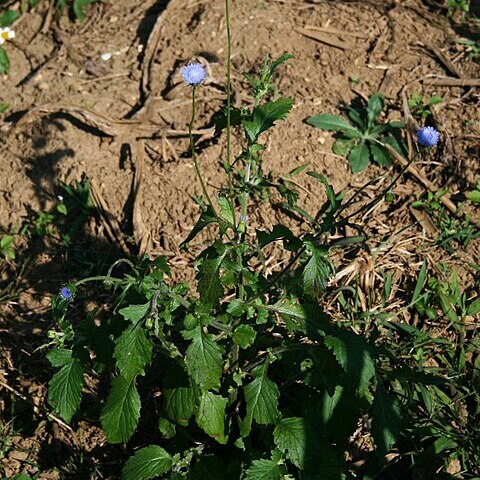Annual herb 20-150 cm tall, erect; stems green striate with purple, densely to sparsely pubescent or setulose. Leaves sessile, obovate, oblanceolate, elliptic or lanceolate, rarely ovate, unlobed or (especially the upper) lyrato-pinnately or pinnately 2-8-lobed, 1.2-20 cm long, 0.5-7.5 cm wide, cuneate or attenuate into an exauriculate petioloid base or (especially the upper) sessile, margins remotely sinuate-denticulate to coarsely sinuate-serrate, apex rounded to obtuse or acute, scattered-pubescent at least on veins beneath. Capitula 1-8, long-stalked, usually at first nodding then ± erect, but sometimes erect throughout, discoid; stalks of the individual capitula ± pubescent and purplish-tinged; involucre cylindrical, 8-13 mm long, 2.5-8 mm in diameter; bract of calyculus 5-23, purplish or dark green with purple tips, lanceolate or narrowly lanceolate, 3-6(-8) mm long, glabrous or ciliate; phyllaries 13-25, commonly 21 or 13, pale green to green, often tinged purple especially towards the apex and purple-tipped, 7.5-12 mm long, glabrous or sparsely shortly pubescent. Disc florets blue, purple or mauve, less often pink or red; corolla 6.2-10.5 mm long, tube glabrous, gradually expanded in upper third, lobes 0.4-1.5 mm long. Achenes 2-2.5 mm long, ribbed, hairy or shortly so in the grooves; pappus 7-12 mm long.
Plants erect, 20-100(-150) cm tall. Stems usually repent at base, striate, simple or few branched, pubescent or subglabrous. Leaves sessile; blade obovate, oblanceolate, elliptic, lanceolate, or ovate, 1-20 × 0.5-7.5 cm, pubescent at least abaxially on veins, cuneate or attenuate into petaloid base, margin sinuate-dentate to sinuate-serrate, unlobed or lyrate-pinnately or pinnately lobed, apex rounded to acute. Capitula 1-8, solitary on long peduncles. Involucres cylindric, 0.8-1.3 cm, with 5-22 calycular bracts; phyllaries uniseriate, linear-lanceolate, equal, ca. 1.5 mm wide, often tinged purple below apex, glabrous or sparsely pubescent, apex purple. Florets tubular, bisexual; corollas blue, purple, or mauve, sometimes pink or red; lobes 5. Style branches acute, papillose. Achenes 2-2.5 mm, ribbed, hairy in grooves. Pappus of numerous white setae, 7-12 mm. Fl. Dec-Apr of next year.
A straggling, more or less erect, sparsely hairy perennial herb, stems up to c. 1 m, simple or sparingly branched. Leaves alternate, up to 10 x 4 cm, ovate or oblong in outline, sessile, auriculate-amplexicaul, the lower ones sometimes attenuated into a petiole-like base, lyrate-pinnatifid or irregularly lobed, sometimes simple, margins coarsely toothed. Heads 1-1.5 x 1 cm, nodding in flower, erect in fruit, solitary on long bracteate peduncles, terminal or in the uppermost leaf axils. Involucral bracts c. 20, a little shorter than the flowers, glabrous. Flowers blue or light or dark-magenta pink. Achenes c. 2 mm long, narrowly cylindric, closely ribbed, white-hispid between the ribs. Pappus of copious white silky hairs many times longer than the achene, deciduous.
An annual herb. It grows 80 cm high. The leaves are arranged in spirals. They do not have leaf stalks. The leaves are deeply cut. Leaves are 5-16 cm long by 2-5 cm wide. The flower heads are red or purple. They are at the top of a long stalk.
Heads 1/2-2/3 in. long on rather long peduncles drooping in flower, erect in fruit
Florets usually bright purple, but occasionally white, pink or blue
An erect branched herb

